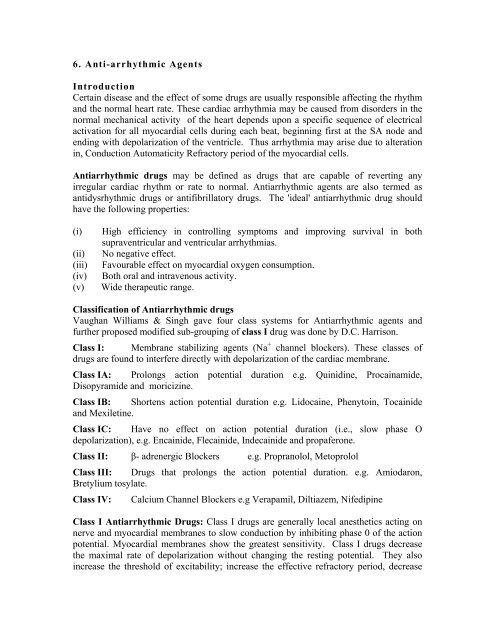MEDICINAL CHEMISTRY
MEDICINAL CHEMISTRY
MEDICINAL CHEMISTRY
Create successful ePaper yourself
Turn your PDF publications into a flip-book with our unique Google optimized e-Paper software.
6. Anti-arrhythmic Agents<br />
Introduction<br />
Certain disease and the effect of some drugs are usually responsible affecting the rhythm<br />
and the normal heart rate. These cardiac arrhythmia may be caused from disorders in the<br />
normal mechanical activity of the heart depends upon a specific sequence of electrical<br />
activation for all myocardial cells during each beat, beginning first at the SA node and<br />
ending with depolarization of the ventricle. Thus arrhythmia may arise due to alteration<br />
in, Conduction Automaticity Refractory period of the myocardial cells.<br />
Antiarrhythmic drugs may be defined as drugs that are capable of reverting any<br />
irregular cardiac rhythm or rate to normal. Antiarrhythmic agents are also termed as<br />
antidysrhythmic drugs or antifibrillatory drugs. The 'ideal' antiarrhythmic drug should<br />
have the following properties:<br />
(i) High efficiency in controlling symptoms and improving survival in both<br />
supraventricular and ventricular arrhythmias.<br />
(ii) No negative effect.<br />
(iii) Favourable effect on myocardial oxygen consumption.<br />
(iv) Both oral and intravenous activity.<br />
(v) Wide therapeutic range.<br />
Classification of Antiarrhythmic drugs<br />
Vaughan Williams & Singh gave four class systems for Antiarrhythmic agents and<br />
further proposed modified sub-grouping of class I drug was done by D.C. Harrison.<br />
Class I: Membrane stabilizing agents (Na + channel blockers). These classes of<br />
drugs are found to interfere directly with depolarization of the cardiac membrane.<br />
Class IA: Prolongs action potential duration e.g. Quinidine, Procainamide,<br />
Disopyramide and moricizine.<br />
Class IB: Shortens action potential duration e.g. Lidocaine, Phenytoin, Tocainide<br />
and Mexiletine.<br />
Class IC: Have no effect on action potential duration (i.e., slow phase O<br />
depolarization), e.g. Encainide, Flecainide, Indecainide and propaferone.<br />
Class II: β- adrenergic Blockers e.g. Propranolol, Metoprolol<br />
Class III: Drugs that prolongs the action potential duration. e.g. Amiodaron,<br />
Bretylium tosylate.<br />
Class IV: Calcium Channel Blockers e.g Verapamil, Diltiazem, Nifedipine<br />
Class I Antiarrhythmic Drugs: Class I drugs are generally local anesthetics acting on<br />
nerve and myocardial membranes to slow conduction by inhibiting phase 0 of the action<br />
potential. Myocardial membranes show the greatest sensitivity. Class I drugs decrease<br />
the maximal rate of depolarization without changing the resting potential. They also<br />
increase the threshold of excitability; increase the effective refractory period, decrease

















